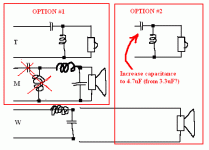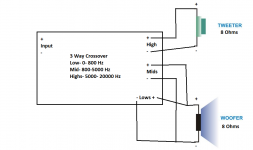Hi,
There is no picture. You can use the mid / treble section of a 3 way c/o
for 2 way speaker, it will work but not well, because the baffle step EQ
needed for a 2-way bass/mid won't be there, and there may be some
matching isssues due to higher bass/mid inductances than for mids.
rgds, sreten.
There is no picture. You can use the mid / treble section of a 3 way c/o
for 2 way speaker, it will work but not well, because the baffle step EQ
needed for a 2-way bass/mid won't be there, and there may be some
matching isssues due to higher bass/mid inductances than for mids.
rgds, sreten.
what Sreten said, you'd need to bypass any HP filter in the mid section, & if you want to add any BSC from an inductor in the 'lows' section, it would need to be in series, the connection shown would put it in parallel.
Better to gain an understanding of how crossovers work, & start from scratch, it's not that hard...
http://www.electusdistribution.com.au/images_uploaded/crossovr.pdf
(Caveat: the charts at the bottom are useless, because the impedance of each driver at the chosen crossover frequency needs to be measured individually)
Better to gain an understanding of how crossovers work, & start from scratch, it's not that hard...
http://www.electusdistribution.com.au/images_uploaded/crossovr.pdf
(Caveat: the charts at the bottom are useless, because the impedance of each driver at the chosen crossover frequency needs to be measured individually)
Rather than wire both the mid and low from the x-over to the woofer, you can skip the low pass woofer and high pass mid part of the circuit all together, just use the low pass half of the mid-range part of the circuit for the woofer and high pass tweeter circuits, that way you don't have a pile of unnecessary x-over components carrying (and likely coloring) the signal. The x-over point will be the same as what you are trying to accomplish, but with likely about half as many components in the signal path.
You can hook up your woofer optionally to:
1) Mid output of the xover
2) Low output of the xover
If your woofer is 5" or above, it will usually have terrible peaks/distortion when producing high frequencies (up to 5KHz specified by your xover), so it is usually better to hook up the woofer to the low output of the xover.
With option #2 chosen, usually you still get the midrange sound from both woofer and tweeter, and it will sound more controlled.
You can try both options and see/hear which one is best (if your ears are trained you can also try flipping the tweeter polarity), but from my experience option #2 will be much better.
1) Mid output of the xover
2) Low output of the xover
If your woofer is 5" or above, it will usually have terrible peaks/distortion when producing high frequencies (up to 5KHz specified by your xover), so it is usually better to hook up the woofer to the low output of the xover.
With option #2 chosen, usually you still get the midrange sound from both woofer and tweeter, and it will sound more controlled.
You can try both options and see/hear which one is best (if your ears are trained you can also try flipping the tweeter polarity), but from my experience option #2 will be much better.

Hello Jay,
I would have to imagine that option 2 would cause an enormous hole in output centered ~2K. Though..if the x-over were 1st order, then the hole might be tolerable (or even appreciated by some "ROCK SETTING EQ OO COOL LIGHTS FLASHY BASS EXPLODE BOOST listeners).
Theoretically you are correct, I don't fully remember (with my implementations in the past). But ready stock crossover is a gamble anyway. It may say 5000Hz but it always sound lower with many "better" tweeter.
And 800Hz is low, but I found many ready stock crossover can go higher than that.
So, better try both ways and listen. Oh, the capacitance in the tweeter should be increased to allow for lower frequency. "Standard" tweeters can easily accept 3KHz even lower.
Last edited:
Hi,
Well it has to be said, off the shelf c/o's are a very bad idea, and trying
to use a 3 way c/o for a two way even worse. The problem with poor
cheap drivers is they usually need overly complex c/o's to work well
and using cheap c/o's only makes the apparent problems worse.
rgds, sreten.
Well it has to be said, off the shelf c/o's are a very bad idea, and trying
to use a 3 way c/o for a two way even worse. The problem with poor
cheap drivers is they usually need overly complex c/o's to work well
and using cheap c/o's only makes the apparent problems worse.
rgds, sreten.
- Status
- This old topic is closed. If you want to reopen this topic, contact a moderator using the "Report Post" button.
- Home
- Loudspeakers
- Multi-Way
- What would happen if...
